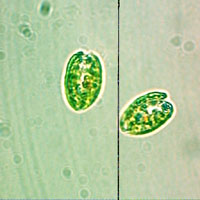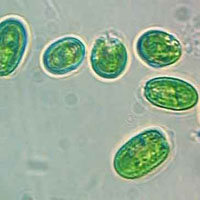Reef Nutrition: Phyto-Feast FAQ
YES – Phyto Feast Live is ALIVE! Over 95% of the cells are alive when bottled and much of it will stay alive for several months.
Check out the viability report from the CCMP
All the microalgae that go into Phyto-Feast Live are grown at our farm in California, harvested live and packed and shipped “farm fresh” every week. Once harvested the algae are induced to become “quiescent,” in “suspended animation.” At the time of bottling 95% or more of the algae are alive.
In this quiescent state metabolic activity and respiration are reduced to minimal levels and the nutritional value of the algae and the integrity of the cell membranes are preserved. The process is similar to cryopreservation where alga can be frozen live for years and remain viable.
Not all of our algae species are equally hardy and over time some of the more delicate cells begin to expire. However some cells will remain viable for two months or more.
Because of the unique quiescence process that is applied to the algae, the cells remain intact and they retain their full nutritional value long after they have ceased metabolic activity. Properly stored, a bottle of Phyto-Feast will provide the same value at two-plus months that it did on the first day.
Does Live Algae Make a Difference?
Yes and No. Cell integrity is critical. Live cells are a clear indication of quality, intact and unprocessed cells. However, microalgae can often retain these qualities when handled properly, whether viable or not.
Can I see Phyto-Feast Live swimming under my microscope?
No. Many kinds of algae do not swim. Other kinds “swim” by the beating of flagella. As a survival response algae lose their flagella under certain conditions – such as during the harvesting process. The flagella don’t grow back so you won’t see any of the algae swimming.
Will microalgae add phosphate and nitrate to my system?
Yes – in very small amounts. There are no added phosphate and nitrates in Phyto-Feast, however these are critical components of all plants so it’s impossible for any microalgae product not to contain some amount. If you have a refugium with some seaweed (Macro-Feast), the seaweed should help pull some of the P&N out of your system. If you experience elevated phosphates there are many products on the market to help lower them, such as Granular Ferric Oxide (GFO).
Phyto-Feast will add much less phosphate and nitrate than algae you grow at home. The algae in Phyto-Feast is separated from the growing media during harvesting, so the only P&N is the small amount actually in the cells, not the media.
There is also a very good article about this by Eric Borneman at reefkeeping.com.
Why is a complete Omega-3 fatty acid profile important?
Omega-3 fatty acids (EPA, DHA, and ARA) are considered essential fatty acids, which means that they are essential to animal health but cannot be manufactured by animals. For this reason, omega-3 fatty acids must be obtained from food. Omega-3 fatty acids can be found in fish and certain plant oils, especially marine microalgae. Also known as polyunsaturated fatty acids (PUFAs), omega-3 and omega-6 fatty acids play a crucial role in brain function as well as normal growth and development.
Different algae can be very different in their Omega-3 fatty acid content. Some, such as Chlorella, contain no EPA or DHA. So it is very important to feed your tank a mixture of carefully chosen algae species for complete and balanced nutrition. The algae in PhytoFeast were specially selected to provide high levels of EPA, DHA and ARA.
Will Phyto-Feast decompose and foul my system?
No. Phyto-Feast cells are intact and not broken so bacteria cannot quickly break them down and cause them to decompose.
Do I need to worry about bacteria or algae blooms if I use Phyto-Feast?
Typically No. Bacterial blooms are typically caused by significant amount of uneaten biomass remained in your system for several days due to overfeeding. Please adhere to the feeding instructions on the bottle to minimize the likelihood of this happening. When first using Phyto-Feast, we recommend you begin at the lowest recommended level and increase as your tank becomes accustomed to the new feed.
Your protein skimmer will likely remove any excess Phyto-Feast from your system.
Which of my animals will feed on Phyto-Feast products?
Some soft corals, sponges, tunicates, gorgonians, sea fans, Basket and Feather Stars, Clams, Mussels, Barnacles, Feather Dusters and Tridachnid clams.
Phyto-Feast™ – Directions & Storage
How Much to Feed?
If you have not used Phyto-Feast™ Live before, start with 1 drop per gallon each day (100 drops = 1.3 teaspoons or 6.5 ml’s) . Your animals will rapidly become accustomed to the phytoplankton (microalgae) and be able to feed on quite a bit more. Common dosage for a mature system is 1-5 drops per gallon each day, depending on your tank setup and animal density.
If your animals do not “clear” the water in less than an hour – back off on the amount you are adding because your systems is not fully digesting all the microalgae.
Always shake the bottle a few times before opening it. The larger algae cells such as Tetraselmis tend to settle to the bottom.
We recommend turning off your skimmer before adding the algae. Many customers have been successful by putting their skimmer on a vacation timer so it automatically turns back on later in the evening (2 hours is a good window).
Tank Size Minimum (Daily)
10 gallons 10 drops (0.65 ml)
50 drops (3.25 ml)
Suggested Maximum (Daily)
100 gallons 100 drops (6.50 ml, 1.3 teaspoon)
500 drops (32 ml, 6.5 teaspoons)
Storage
Phyto-Feast must be stored in your refrigerator. The best place to store algae is the bottom shelf, it is the coldest place in your refrigerator. The worst place to store it is the refrigerator door – it is too warm. Phyto-Feast cannot be frozen – that will break many of the algae cells.


